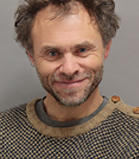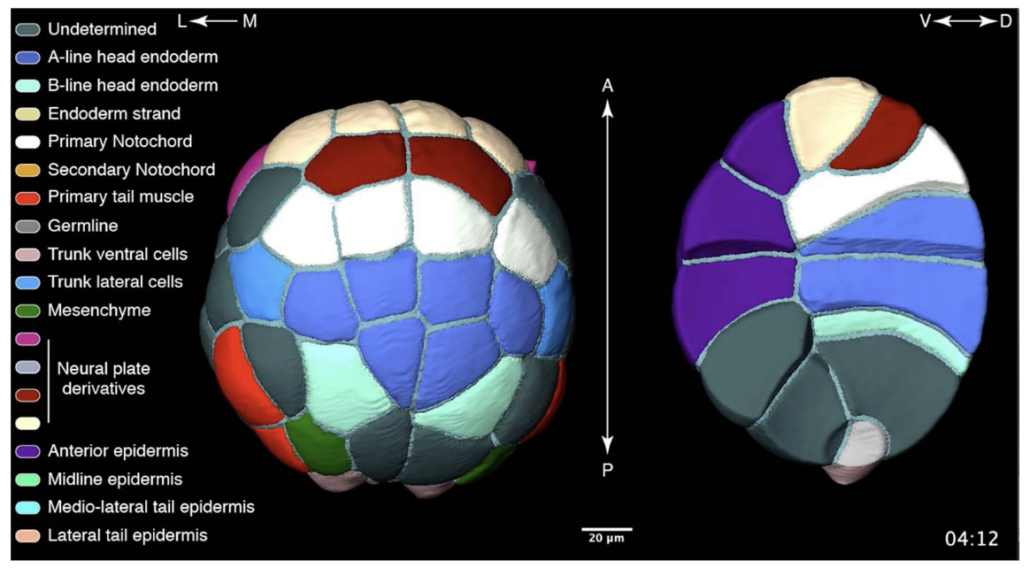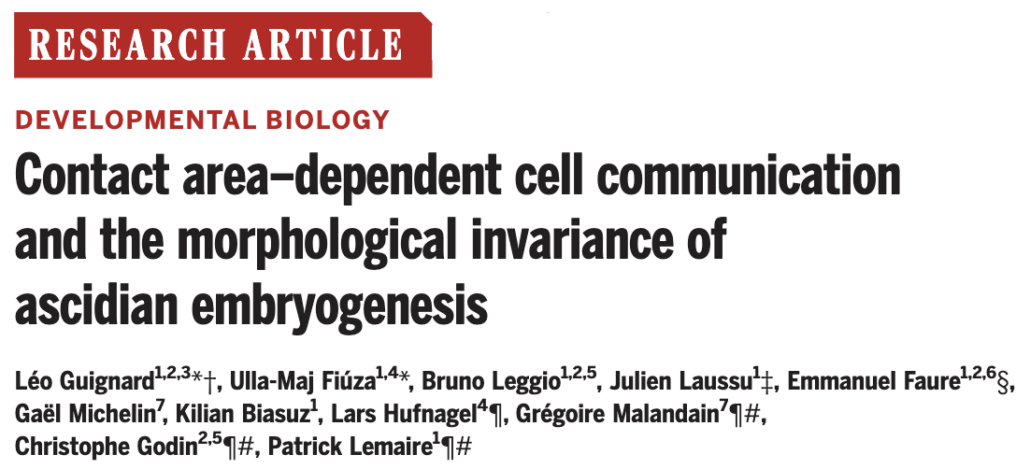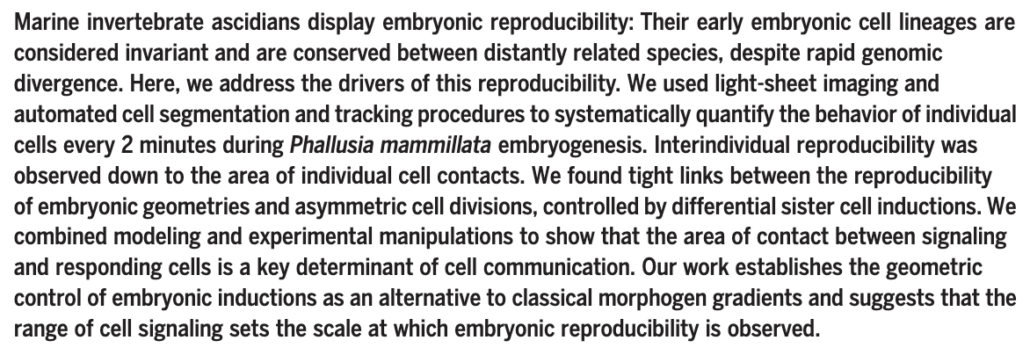
Our Research
We study the embryos of ascidians, a group of small marine invertebrates some of which are seen as delicacies in France and Japan (sea squirts, sea pineapples). We chose this group of animals because the different species included in this group have very different genomes, but develop in an almost identical manner, such that homologous cells can be found across all embryos of a species, and even between distantly related species!
To understand this apparent paradox, we combine light-sheet imaging of live embryos, (epi)genome sequencing, classical embryology and computer modelling. Our hope is that this work will allow us to better understand the sometimes tortuous paths of species evolution.
Biologists have long been puzzled by the different rates of morphological evolution of animal species. Why do some taxa undergo rapid morphological changes while others, such as the coelacanth, can keep very similar morphologies over hundreds of millions of years? Is this correlated with the rates of genome divergence, or does this involve specific mechanisms to buffer or enhance the impact of genetic divergence? Our group is exploring the complex relationships between genotype and phenotype at the crossroad of developmental biology, computational biology, evolutionary biology and cell biology.
As a model system we use the embryos of ascidians (Left) because of the anatomical and genomic simplicity of these marine invertebrates, which are closely related to vertebrates. These embryos develop with a fixed cell lineage that is remarkably well conserved between all studied species, even in those with genomes that have extensively diverged for up to 400 million years of parallel evolution. Ascidians thus offer a unique opportunity to decipher the developmental program of a chordate with a cellular level of resolution, and to understand how genomic plasticity is compatible with morphological conservation. This latter phenomenon is referred to as Developmental Systems Divergence (DSD) and may explain why the modelling of human diseases in animal models is not always successful.
To identify the molecular and cellular mechanisms underlying the striking evolutionary stability of ascidian morphogenesis, we combine advanced quantitative imaging with epigenetics, transcriptomics and cis-regulatory analyses. Our major aims are: 1) to elucidate the evolution of the repertoire of developmental ascidian regulatory proteins and their regulation; 2) to fully reconstruct and quantify the single-cell dynamics and cell lineage trees during ascidian morphogenesis and its evolution through advanced light-sheet microscopy and computational image analysis.
Have a look at the small animation movie made by Laurence Serfaty and Isis Leterrier, two professional directors, about our work on the computational reconstruction of embryogenesis with single cell resolution, and how the range of cell communication may play a role in the cellular reproducibility of development.

En savoir plus
Financements
ANR Cell Whisper (Patrick Lemaire)
ANR scEmbryoMech (Patrick Lemaire)
ANR CionaConnect (Patrick Lemaire)
FRM (Patrick Lemaire)
Publications
2025
- Transcriptomes of a fast-developing chordate uncover drastic differences in transcription factors and localized maternal RNA composition compared with those of ascidians.. Wang K, Suyama R, Mizutani N, Matsuo M, Peng Y, Seki M, Suzuki Y, Luscombe NM, Dantec C, Lemaire P, Toyoda A, Nishida H, Onuma TA. Development. 2025 Mar 15;152(6):DEV202666. Pubmed
2024
- Physical modeling of embryonic transcriptomes identifies collective modes of gene expression. Skinner DJ, Lemaire P, Mani M. bioRxiv [Preprint]. 2024 Aug 4:2024.07.26.605398. Pubmed
2022
- Protein kinases and protein phosphatases encoded in the Ciona robusta genome. Tokuoka M, Kobayashi K, Lemaire P, Satou Y. Genesis. 2022 Mar;60(3):e23471. Pubmed
- Methods for the Study of Apical Constriction During Ascidian Gastrulation. Fiuza UM, Lemaire P. Methods Mol Biol. 2022;2438:377-413. Pubmed
2021
- Mechanical and genetic control of ascidian endoderm invagination during gastrulation. Fiuza UM, Lemaire P. Semin Cell Dev Biol. S1084-9521(21)00205-6 Pubmed
2020
- A genome database for a Japanese population of the larvacean Oikopleura dioica. Wang K, Tomura R, Chen W, Kiyooka M, Ishizaki H, Aizu T, Minakuchi Y, Seki M, Suzuki Y, Omotezako T, Suyama R, Masunaga A, Plessy C, Luscombe NM, Dantec C, Lemaire P, Itoh T, Toyoda A, Nishida H, Onuma TA. Dev Growth Differ. 62(6):450-461 Pubmed
- Nodal/Eph signalling relay drives the transition between apical constriction and apico-basal shortening during ascidian endoderm invagination. Fiuza UM, Negishi T, Rouan A, Yasuo H and Lemaire P. Development, 2020 Aug 14;147(15):dev186965. Pubmed
- Contact Area-Dependent Cell Communication and the Morphological Invariance of Ascidian Embryogenesis. Guignard L, Fiúza UM, Leggio B, Laussu J, Faure E, Michelin G, Biasuz K, Hufnagel L, Malandain G, Godin C, Lemaire P. Science . 2020 Jul 0;369(6500):eaar5663. Pubmed
2019
- ANISEED 2019: 4D exploration of genetic data for an extended range of tunicates. Dardaillon J, Dauga D, Simion P, Faure E, Onuma TA, DeBiasse MB, Louis A, Nitta KR, Naville M, Besnardeau L, Reeves W, Wang K, Fagotto M, Guéroult-Bellone M, Fujiwara S, Dumollard R, Veeman M, Volff JN, Roest Crollius H, Douzery E, Ryan JF, Davidson B, Nishida H, Dantec C, Lemaire P. Nucleic Acids Res. 2020 Jan 8;48(D1):D668-D675. Pubmed
- Evolution of the embryonic cis-regulatory landscapes between divergent Phallusia and Ciona ascidians. Madgwick , Magri MS, Dantec C, Gailly D, Fiuza UM, Guignard L, Hettinger S, Gomez-Skarmeta JL, and Lemaire P. Dev Biol. 448(2):71-87 Pubmed
- High-Throughput Protein Production Combined with High-Throughput SELEX Identifies an Extensive Atlas of Ciona robusta Transcription Factor DNA-Binding Specificities. Nitta KR, Vincentelli R, Jacox E, Cimino A, Ohtsuka Y, Sobral D, Satou Y, Cambillau C, and Lemaire P. Methods Mol Biol. 2019;2025:487-517. Pubmed
- MorphoNet: An interactive online morphological browser to explore complex multi-scale data. Leggio B, Laussu J, Carlier A, Godin C, Lemaire P and Faure E. Nat. Commun. 2019 Jun 27;10(1):2812. Pubmed
- Multiscale mechanical model for cell division orientation in developing biological systems. Leggio B, Laussu J, Faure E, Lemaire P and Godin C. bioRxiv 785337 Pubmed
- Transcriptional regulation of the Ciona Gsx gene in the neural plate. Hudson C, Esposito R, Palladino A, Staiano L, Ferrier D, Faure E, Lemaire P, Yasuo H, Spagnuolo A. Dev Biol. 2019 Apr 15;448(2):88-100. Pubmed
2018
- ANISEED 2017: extending the integrated ascidian database to the exploration and evolutionary comparison of genome-scale datasets. Brozovic M, Dantec C, Dardaillon J, Dauga D, Faure E, Gineste M, Louis A, Naville M, Nitta KR, Piette J, Reeves W, Scornavacca C, Simion P, Vincentelli R, Bellec M, Aicha SB, Fagotto M, Guéroult-Bellone M, Haeussler M, Jacox E, Lowe EK, Mendez M, Roberge A, Stolfi A, Yokomori R, Brown CT, Cambillau C, Christiaen L, Delsuc F, Douzery E, Dumollard R, Kusakabe T, Nakai K, Nishida H, Satou Y, Swalla B, Veeman M, Volff JN, Lemaire P. Nucleic Acids Res. 2018 Jan 4;46(D1):D718-D725. Pubmed
- ANISEED 2017: extending the integrated ascidian database to the exploration and evolutionary comparison of genome-scale datasets. Brozovic M, Dantec C, Dardaillon J, Dauga D, Faure E, Gineste M, Louis A, Naville M, Nitta KR, Piette J, Reeves W, Scornavacca C, Simion P, Vincentelli R, Bellec M, Aicha SB, Fagotto M, Guéroult-Bellone M, Haeussler M, Jacox E, Lowe EK, Mendez M, Roberge A, Stolfi A, Yokomori R, Brown CT, Cambillau C, Christiaen L, Delsuc F, Douzery E, Dumollard R, Kusakabe T, Nakai K, Nishida H, Satou Y, Swalla B, Veeman M, Volff JN, Lemaire P. Nucleic Acids Res. 46(D1):D718-D725. Pubmed
- A phylogenomic framework and timescale for comparative studies of tunicates. Delsuc F, Philippe H, Tsagkogeorga G, Simion P, Tilak MK, Turon X, López-Legentil S, Piette J, Lemaire P, Douzery EJP. BMC Biol. 16(1):39. Pubmed
- Convergent Acquisition of Nonembryonic Development in Styelid Ascidians. Alié A, Hiebert LS, Simion P, Scelzo M, Prünster MM, Lotito S, Delsuc F, Douzery EJP, Dantec C, Lemaire P, Darras S, Kawamura K, Brown FD, Tiozzo S. Mol Biol Evol. 35(7):1728-1743. Pubmed
2017
- Genome-wide survey of miRNAs and their evolutionary history in the ascidian, Halocynthia roretzi. Wang K, Dantec C, Lemaire P, Onuma TA, Nishida H. BMC Genomics. 18(1):314. Pubmed
2016
- ANISEED 2015: a digital framework for the comparative developmental biology of ascidians. Brozovic M, Martin C, Dantec C, Dauga D, Mendez M, Simion P, Percher M, Laporte B, Scornavacca C, Di Gregorio A, Fujiwara S, Gineste M, Lowe EK, Piette J, Racioppi C, Ristoratore F, Sasakura Y, Takatori N, Brown TC, Delsuc F, Douzery E, Gissi C, McDougall A, Nishida H, Sawada H, Swalla BJ, Yasuo H, Lemaire P. Nucleic Acids Res. 44:D808-18. Pubmed
2015
- Guidelines for the nomenclature of genetic elements in tunicate genomes. Stolfi A, Sasakura Y, Chalopin D, Satou Y, Christiaen L, Dantec C, Endo T, Naville M, Nishida H, Swalla BJ, Volff JN, Voskoboynik A, Dauga D, Lemaire P. 53:1-14. Pubmed
- Thaliaceans, the neglected pelagic relatives of ascidians : a developmental and evolutionary enigma. Piette J, Lemaire P. Q Rev Biol. 90:117-45. Pubmed
- Tunicates: exploring the sea shores and roaming the open ocean. A tribute to Thomas Huxley. Lemaire P, Piette J. Open Biol. 5:150053. Pubmed
- A pipeline for the systematic identification of non-redundant full-ORF cDNAs for polymorphic and evolutionary divergent genomes: Application to the ascidian Ciona intestinalis. Gilchrist MJ, Sobral D, Khoueiry P, Daian F, Laporte B, Patrushev I, Matsumoto J, Dewar K, Hastings KE, Satou Y, Lemaire P, Rothbächer U. Dev Biol. 404(2):149-63. Pubmed
2014
- An otx/nodal regulatory signature for posterior neural development in ascidians. Roure A, Lemaire P, Darras S. PLoS Genet. 10:e1004548. Pubmed
2013
- DNA-binding specificities of human transcription factors. Jolma A, Yan J, Whitington T, Toivonen J, Nitta KR, Rastas P, Morgunova E, Enge M, Taipale M, Wei G, Palin K, Vaquerizas JM, Vincentelli R, Luscombe NM, Hughes TR, Lemaire P, Ukkonen E, Kivioja T, Taipale J. 152(1-2):327-39. Pubmed
- Highly conserved elements discovered in vertebrates are present in non-syntenic loci of tunicates, act as enhancers and can be transcribed during development. Sanges R, Hadzhiev Y, Gueroult-Bellone M, Roure A, Ferg M, Meola N, Amore G, Basu S, Brown ER, De Simone M, Petrera F, Licastro D, Strähle U, Banfi S, Lemaire P, Birney E, Müller F, Stupka E. Nucleic Acids Res. 41(6):3600-18. Pubmed
2012
- Antagonizing retinoic acid and FGF/MAPK pathways control posterior body patterning in the invertebrate chordate Ciona intestinalis. Pasini A, Manenti R, Rothbächer U, Lemaire P. PLoS One. 7(9):e46193. Pubmed
2011
- Evolutionary crossroads in developmental biology: the tunicates. Lemaire P. Development. 138(11):2143-52. Pubmed
- Time-lapse imaging of live Phallusia embryos for creating 3D digital replicas. Robin FB, Dauga D, Tassy O, Sobral D, Daian F, Lemaire P. Cold Spring Harb Protoc. 2011(10):1244-6. Pubmed
- Imaging of fixed ciona embryos for creating 3D digital replicas. Robin FB, Dauga D, Tassy O, Sobral D, Daian F, Lemaire P. Cold Spring Harb Protoc. 2011(10):1247-50. Pubmed
- Creating 3D digital replicas of ascidian embryos from stacks of confocal images. Robin FB, Dauga D, Tassy O, Sobral D, Daian F, Lemaire P. Cold Spring Harb Protoc. 2011(10):1251-61. Pubmed
Transcriptional control of chordate morphogenesis
 Patrick LEMAIRE
Patrick LEMAIRE
Group leader (Research Director CNRS)
Team Members
(Directeur de Recherche) 0434359563 |
|
(Maître de conférences) +33 (0)4 34 35 95 59 |
|
(Doctorant) +33 (0)4 34 35 95 63 |
|
(Doctorant) +33 (0)4 34 35 96 53 |

Contact us
Replace the name and address below with that of the member to contact
prenom.nom@crbm.cnrs.fr












